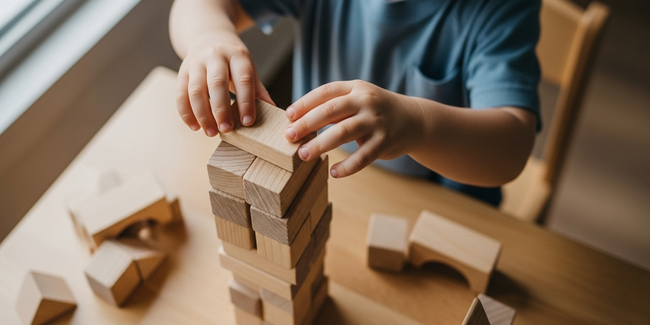Have you ever watched your toddler meticulously stack a tower of blocks, their brow furrowed in concentration, only to demolish it with a gleeful shriek moments later? It might look like chaos, but you’re witnessing the work of a tiny engineer, architect, and scientist all at once. This is construction play, and it’s one of the most important jobs of early childhood.
In a world filled with pressure for early academic achievement, it’s easy to dismiss this noisy, often messy, activity as just ‘playing’. But at Okinja Early Learning Centre & Kindergarten, our deep experience in play-based learning has shown us a profound truth: when a toddler is building, they are forging the very architecture of their developing mind.
This guide will reveal how construction play is far more than just ‘playing with blocks.’ It is a fundamental process where your toddler builds their brain, body, and emotional resilience, laying the groundwork for future success in school and in life. We believe that by understanding the deep science behind the play, you can feel confident and empowered in supporting your child’s most important work.
The Blueprint of Play: Why Construction is a Toddler’s Most Important Work
At its core, construction play is the act of combining materials to create something new. It’s the stacking of wooden blocks, the linking of magnetic tiles, the moulding of sand, and the arranging of shells and sticks into a pattern. It is an active, hands-on investigation of the physical world.
This isn’t passive entertainment; it’s a cognitive powerhouse. Every time your child engages in construction, their brain is firing on all cylinders, building neural pathways related to physics, mathematics, problem-solving, and creativity. This aligns directly with the core principles of Australia’s Early Years Learning Framework (EYLF), which champions play-based experiences that nurture children to become “confident and involved learners” (Outcome 4). Construction play is the living, breathing embodiment of this outcome—it is learning made visible.
As outlined in the National Quality Standard (NQS), a high-quality educational program (Quality Area 1) must be built on such intentional, play-based experiences that support every aspect of a child’s development. We see construction play not as a single activity, but as a holistic developmental engine.
The Developmental Journey: From Stacker to Architect
One of the most remarkable things about construction play is how it evolves in complexity, perfectly mirroring your child’s cognitive growth. At Okinja, our highly qualified educators are skilled in observing and supporting children through these distinct, wonderful phases.
Phase 1: The Stacker (Approx. 12-24 months)
In the beginning, it’s all about exploration and discovery. A young toddler isn’t trying to build a castle; they are figuring out the very nature of the objects in their hands.
- What it looks like: Grasping, dropping, banging blocks together, lining them up, and stacking two or three before they tumble.
- The Hidden Learning: This is a full-body science experiment. Your child is learning about weight, texture, sound, and, most importantly, cause and effect. “When I let go of the block, it falls.” This is their first lesson in gravity. The fine motor control required to grasp a block and intentionally place it on another is a monumental neurological achievement, strengthening the hand-eye coordination essential for future writing.
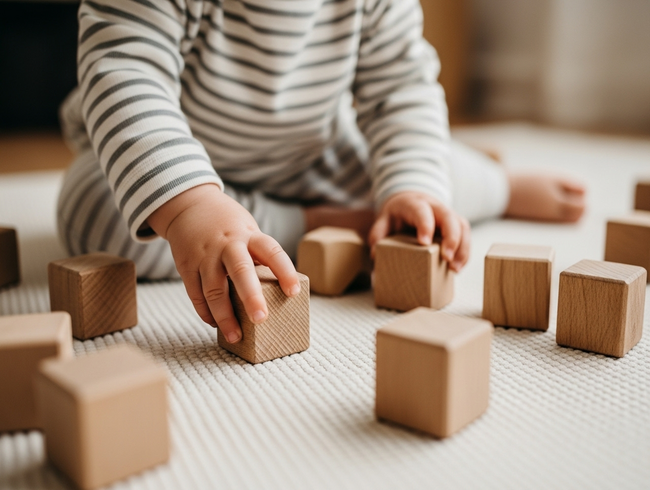
Phase 2: The Builder (Approx. 2-3 years)
As their thinking becomes more sophisticated, so do their constructions. Intentionality enters the picture. The play is no longer just about the blocks themselves, but about what the blocks can become.
- What it looks like: Building simple, repetitive structures like long, flat “roads” or tall, vertical towers. They might start naming their creations: “This is a house for teddy.”
- The Hidden Learning: This is the dawn of symbolic thinking—the understanding that one object can represent another. This is a crucial cognitive leap that underpins all future learning, from reading to mathematics. They are also engaging in early-stage problem-solving. “If I want my tower to be taller, I need to place the blocks very carefully.” They begin to intuitively grasp concepts of balance, stability, and rudimentary geometry.
Phase 3: The Architect (Approx. 3+ years)
Now, imagination takes the lead. Constructions become more complex, detailed, and often integrated into elaborate pretend-play scenarios.
- What it looks like: Creating enclosures (“a fence for the animals”), bridging gaps between two structures, and building elaborate, multi-part designs like castles with walls or cities with roads. Crucially, this phase often becomes social.
- The Hidden Learning: This is where collaboration and communication skills flourish. Children must negotiate roles (“You build the wall, and I’ll build the tower”), share resources, and solve problems as a team. They are developing theories, testing hypotheses, and using increasingly complex language to explain their ideas. This is foundational STEM learning in its most authentic form.
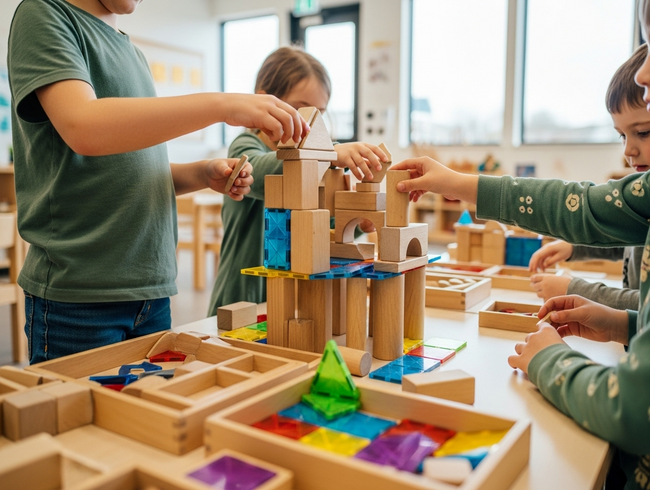
Decoding the “Destruction Phase”: The Science of Knocking Things Down
We must address the one aspect of construction play that causes the most parental anxiety: the gleeful demolition. Why does your toddler spend so much time building something, only to knock it down with such joy?
It’s tempting to see this as a negative or destructive act, but from a developmental standpoint, it is just as valuable as the building itself. This is not misbehaviour; it is research.
When your child knocks down a tower, they are:
- Testing a Hypothesis: “What will happen if I push this?” They are confirming their understanding of cause and effect in the most dramatic and satisfying way possible.
- Exploring Power and Control: For a small person in a big world, the ability to cause such a significant change is incredibly empowering. It gives them a sense of agency.
- Learning About Deconstruction: To truly understand how something is built, you must also understand how it comes apart. This is a critical part of the engineering process.
- Building Resilience: Most importantly, they learn that if something falls, it’s not the end. You can always gather the pieces and begin again. This cycle of building, falling, and rebuilding is perhaps the most powerful lesson in resilience they will ever receive.
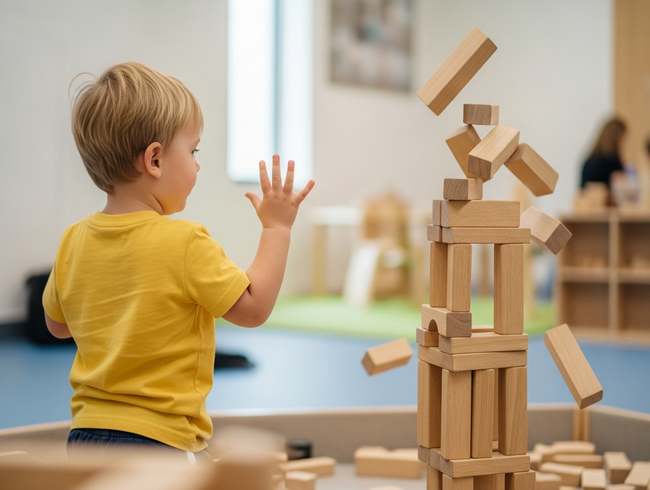
Building the Foundations for Life: Lifelong Skills Forged in Play
The benefits of regular, open-ended construction play ripple out into every area of your child’s life, preparing them not just for school, but for a future we can’t yet imagine.
- Budding Scientists & Mathematicians: They aren’t just playing with blocks; they’re experimenting with gravity, learning about spatial awareness, sorting by shape and size (classification), counting, and discovering that two small blocks can be the same size as one large one (fractions). This is tangible, real-world STEM.
- Resilient Problem-Solvers: When a bridge collapses or a wall won’t stand up, they don’t give up. They adapt. They try a wider base, a different block, a new approach. This trial-and-error process is the very heart of critical thinking and builds the emotional muscle to face future challenges with tenacity.
- Creative Communicators: Children use rich language to plan, describe, and narrate their play. “We need a long, flat block for the bridge over the river!” They tell stories about their creations, developing narrative skills and an expressive vocabulary.
- Confident Physical Navigators: The precise movements required to place a block without toppling the tower are powerful fine motor skill development activities, refining the pincer grasp and fine motor skills necessary for writing, drawing, and using tools. Reaching, stretching, and carrying larger blocks develops their gross motor skills and physical confidence.
How We Nurture Young Engineers at Okinja
The cornerstone of our philosophy at Okinja Early Learning Centre & Kindergarten is our unwavering belief that the environment is the ‘third teacher.’ This principle, central to providing a high-quality physical environment (Quality Area 3 of the NQS), means that a learning space must be more than just a room with toys. It must be an intentional, inspiring, and safe landscape for discovery.
This is why we move beyond simply providing a tub of plastic blocks. Our centre is thoughtfully curated with a rich variety of open-ended construction materials. You will find natural wood blocks of all shapes and sizes, magnetic tiles that click together with satisfying ease, and an ever-changing collection of “loose parts”—recycled materials, tubes, boxes, and natural treasures gathered from our unique Sunshine Coast surroundings. Our four separate playgrounds become extensions of this learning, offering sand, water, stones, and sticks as the raw materials for imaginative engineering.
Our role as educators is not to direct the play, but to facilitate it. We are co-conspirators in discovery, asking thoughtful questions to extend their thinking: “I wonder what would happen if we used a wider block at the bottom?” or “That’s a tall tower! How can we make it even stronger?” We observe, document, and thoughtfully add resources that challenge and expand their play, ensuring every child is supported in their unique developmental journey.
Empowering Your Builder at Home
You can easily nurture this powerful form of learning at home, often with little to no cost.
- Think Beyond the Toy Store: The best construction materials are often free. Cardboard boxes of all sizes, plastic bottles, egg cartons, and paper towel tubes are invitations to create.
- Gather Nature’s Building Blocks: A walk in Alex Forest Bushland Park or along the beach can yield a treasure trove of building materials: sticks, pebbles, shells, and gumnuts.
- Embrace the Process, Not the Product: Focus your praise on their effort and thinking, not just the final creation. “You worked so hard to make that balance!” is more valuable than “What a pretty house.”
- Become a Play Partner: Sit with your child and simply observe. Pass them the block they’re reaching for. Wonder aloud with them. Your engaged presence, without taking over, communicates that their work is valuable and important.
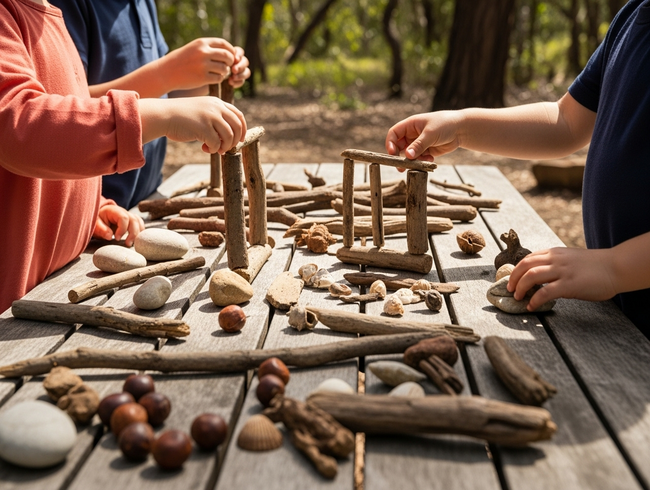
The Foundation for a Lifetime of Learning
From the very first unsteady stack to a sprawling, collaborative city, construction play is one of the most powerful learning tools available to a child. It is a dynamic process that simultaneously develops their mind, their body, and their character. It teaches them to be thinkers, creators, and collaborators.
At Okinja Early Learning Centre & Kindergarten, we are committed to honouring this essential work of childhood. We foster an environment where children feel safe to explore, to experiment, to fail, and to try again, building a foundation of confidence and curiosity that will last a lifetime.

The best way to understand the power of our play-based philosophy is to see the joy and deep learning it sparks in person. We invite you to book a tour to see how our expert educators intentionally design experiences that turn a child’s natural curiosity into a foundation for lifelong learning. You’ll see how our thoughtful indoor spaces and enriching outdoor areas work together to support this powerful approach. Contact Okinja ELC on 07 5479 2222 to arrange your visit.

